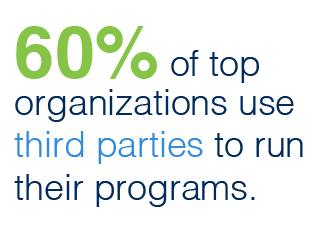In past blogs, we’ve written at length about channel incentives and enablement.
We’ve talked about why partner channels aren’t for everyone.
We’ve discussed how to build long-term channel equity.
We’ve even tried to peer into our incentive crystal ball and predict the future of channel enablement and incentives (spoiler: it looks a lot like the present).
Of course, with a topic as broad as channel incentives, there are a lot of different ways to look at it.
Are channel programs effective? What seems to be working for successful channel organizations? How do channel partners feel about their programs? What are some of the current vendor best practices as identified by channel partners themselves?
On The Rise
To begin, incentive programs appear to be flourishing across the board.
For incentive travel programs, per-person spending has risen 4% to $3,915 per-person, while a growing number of companies (57%) with gift card and merchandise programs have seen their per-person spending rise to $251-$5,000.
Channel incentives have been no exception to this across-the-board growth.
In fact, according to a Marketplace Study by the Incentive Federation, between the years 2013 and 2015, the use of channel rewards among businesses rose 15%, with companies spending upwards of $17 billion on channel programs alone (and some estimates reaching even higher than this).
Channel Success
Clearly, organizations are increasingly buying into the idea that incentive programs bring value. But are these programs working—particularly when it comes to the channel?
Recent research would suggest yes.
An Incentive Research Foundation (IRF) case study, featuring a Fortune 500 manufacturer and distributor, showed that non-cash channel programs can have a tremendous financial impact.
The program initiated by this company produced a 32% increase in total revenue, a 30% increase in market share, and a 19% increase in net operating income.
These results are supported by research conducted by the Silicon Valley Research Group, who found that incentives boost partner sales and profits by as much as 40%.
Be The Best
So, let’s say you’re an organization that’s interested in creating an incentive program for my distribution channel. The research may very well be compelling, but where do you begin?
My advice would be to emulate what other top companies are doing.
For example, according to the IRF, two-thirds of top-performing companies structure their programs to reach as many eligible participants as possible, so casting a wide-net would seem to be a good place to start.
Additionally, these top organizations tend to focus more on individualized sales quotas, with 73% using these to reward participants versus only 51% of all other organizations.
One challenge of managing a channel incentive program is that channel partners are dispersed and varied, and thus hard to unify under a common platform or rules structure.
For example, one partner marketing report found that “as [channel] marketers are pushed to maximum capacity, their need for a single interface to manage all [channel] marketing activity continues to grow.”
The report additionally found that 90% of top-performing companies have found a way to either manage multiple programs under a common purpose (48%), or else create a single program for the entire company (42%).
Conversely, this was only true for 17% of average companies. As a result, understanding the value of overcoming this challenge could explain why over 60% of top organizations use third parties to run their programs.
Best Practices: Administration, Communication, Support
Of all the key program elements, administration, communication, and support seem to be most important to top-performing companies.
On average, 48% of a typical program budget for a top organization goes to program administration, as opposed to only 30% for average-performing organizations.
Further, perhaps because fair and clearly communicated earning criteria were viewed as important by program participants, top companies were far more likely (86%) to integrate channel program communications into their broader communications strategies.
Finally, to get the most out of their channel partners, it appears that top organizations are also increasingly likely to provide targeted assistance, with one study finding that over 80% of these companies offer specific marketing and lead generation support to partners.
What’s Missing?
In spite of all of the above, channel partners today still find some aspects of vendor services to be lacking.
For example, one study found that despite the high correlation between relationships and performance, fewer than 20% of channel partner relationships actually achieve “trusted partner status.”
This was echoed by the aforementioned IRF study, which suggests that establishing connections with executive leadership can “contribute significantly to [program] success.”
In addition, although top companies have made an effort to unify their channel program strategies, this tactic does not seem to be nearly as widespread nor effective as channel partners would like.
In fact, nearly one-third of respondents to a recent partner survey claimed that they used manufacturer platforms to execute less than 5% of their overall marketing during efforts in the previous 6 months, specifically citing feeling overwhelmed at having to manage multiple platforms from multiple vendors.
Finally, while partners agree that vendor-created content can be very useful, a need for more targeted, customized content seems to be common.
Less than half of respondents to the partner survey described their vendor-created content as “very useful,” with a number of respondents suggesting that the content lacked specific industry knowledge or seemed to take on a one-size-fits-all approach.
What’s Next?
After sifting through the research, a few key best practices start to develop.
First, for channel incentive programs to be successful, they need to be as simple and clearly communicated as possible, with consistent vendor support provided throughout. This includes components like having a well-defined rules structure and straightforward, timely incentive payments.
Ultimately, greater trust between channel partners and vendors will produce greater effectiveness of channel incentive programs.
Also, vendors should focus more specifically on partner and end-user issues, especially when it comes to marketing content.
Partners increasingly expect channel knowledge to be a two-way street, so the more partners can learn about their individual partners and the challenges they face, the better.
This ties into the desire of partners to establish more significant relationships with manufacturers and distributors in their channel. By creating relationships that are less purely transactional and involve some level of strategic collaboration, vendors can establish greater buy-in from their partners.
Ultimately, the great determiner in the success of a channel incentive seems to be engagement.
All of the efforts highlighted above are designed to facilitate greater engagement among channel partners, who might otherwise view the competing interests of vendors in their channel as impersonal or indifferent.
If organizations want more of their channel to be committed to them, their products, and their programs, it’s incumbent on them to provide a program experience that’s valuable.
And this means understanding channel partner needs, providing effective, timely, solutions, and forging meaningful relationships.
If you want to learn more about what makes a channel incentive program successful, download out guide: The Definitive Guide to an Effective Channel Incentive Program.
Sources
Photo by Zac Durant on Unsplash
http://blog.hmiaward.com/partner-channels-arent-for-everyone-heres-why
http://blog.hmiaward.com/bid/97393/How-To-Build-Long-Term-Channel-Equity
http://blog.hmiaward.com/channel-enablement-incentives-a-glimpse-5-years-into-the-future
http://theirf.org/research/roi-incentive-programs-a-case-study-for-channel-sales-success/1055/




